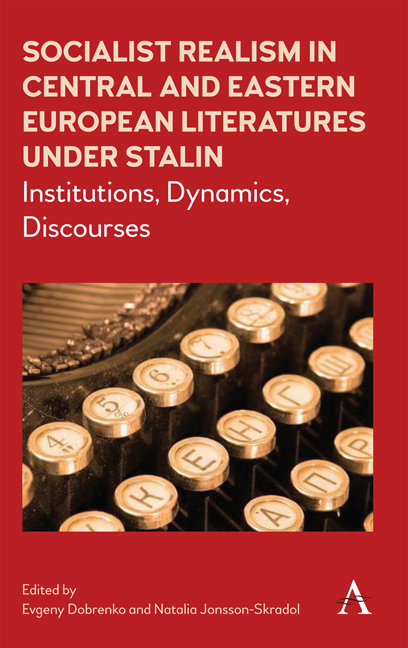 Socialist Realism in Central and Eastern European Literatures under Stalin
Socialist Realism in Central and Eastern European Literatures under Stalin Book contents
- Frontmatter
- Contents
- Acknowledgements
- Introduction
- Part 1 Institutions
- Part 2 Dynamics
- Part 3 Discourses
- 15 Introducing Socialist Realism in Hungary, 1945– 51: How Politics Made Aesthetics
- 16 When Writers Turn against Themselves: The Soviet Model and the Bulgarian Experience, 1946–56
- 17 Big Brother's Gravity: East European Literature in the Mirror of Soviet ‘Thick Journals’ in the Late 1940s
- 18 The Coming One: Prolegomena to the Positive Hero of Czech Socialist Realism as a Transforming and Transformed Subject
- 19 Will Freedom Sing as Beautifully as Captives Sang about It? Reshaping the Croatian Canon, 1945–55
- 20 The Salon in the Camp: Friendship Societies and the Literary Public Sphere in the SBZ and Early GDR
- Conclusion
- List of Contributors
- Index
20 - The Salon in the Camp: Friendship Societies and the Literary Public Sphere in the SBZ and Early GDR
from Part 3 - Discourses
Published online by Cambridge University Press: 10 May 2018
- Frontmatter
- Contents
- Acknowledgements
- Introduction
- Part 1 Institutions
- Part 2 Dynamics
- Part 3 Discourses
- 15 Introducing Socialist Realism in Hungary, 1945– 51: How Politics Made Aesthetics
- 16 When Writers Turn against Themselves: The Soviet Model and the Bulgarian Experience, 1946–56
- 17 Big Brother's Gravity: East European Literature in the Mirror of Soviet ‘Thick Journals’ in the Late 1940s
- 18 The Coming One: Prolegomena to the Positive Hero of Czech Socialist Realism as a Transforming and Transformed Subject
- 19 Will Freedom Sing as Beautifully as Captives Sang about It? Reshaping the Croatian Canon, 1945–55
- 20 The Salon in the Camp: Friendship Societies and the Literary Public Sphere in the SBZ and Early GDR
- Conclusion
- List of Contributors
- Index
Summary
‘They're toys’, says J. F. Sebastian, ‘my friends are toys. I make them. It's a hobby.’
(Bladerunner)‘Lager oder Salon’ (‘Camp or Salon’) was the title of an article published in a mainstream National Socialist newspaper in 1935. The subtitle of the article was ‘Wandel der Lebensformen’ (‘A Transformation of Lifestyle’), the reference being to the inevitable decision awaiting each citizen of the country: either in favour of the cosy, comfortable, individualistic bourgeois salon, or else in favour of the rough, primitive, communal barracks of the comrades’ working camps, these latter being the embodiment of the new spirit, of the future itself. Citizens of the countries that fell within the Soviet zone of influence after World War II were also in for a transformation of (life)style that was quite radical, though of a completely different kind. Now, it was no longer about a choice between a salon and a camp; now, a salon in a camp was being set up. A different camp, of course – not a labour camp, but that of the progressive socialist countries. And the ‘salon’ would need to be understood as an allusion to the eighteenth century European salons, those special places where the enlightened, the educated and the curious would come together to discuss the affairs of the day. These were the origins, according to Jürgen Habermas, of the ‘bourgeois public sphere’ – the time– space that gave rise to some modern professions, including journalism and art criticism, and maybe even to the very modern subjectivity of a politically and socially conscious individual.
Speaking of ‘the salon’ as a synecdoche of the public sphere in conjunction with ‘a camp’ may seem somewhat counter- intuitive. The original German term of Öffentlichkeit directly alludes to openness and transparency – not qualities one would normally associate with a camp. Rittersporn, Behrends and Rolf justly claim that insofar as the public sphere rooted in the West European Enlightenment came to be seen as a foundation of the civil public sphere of an open society, it is regarded as a direct opposite of the closed structures of totalitarian states, and any use of the term in the context of post- war Eastern and Central Europe requires an understanding of the contextual specificity.
- Type
- Chapter
- Information
- Socialist Realism in Central and Eastern European Literatures under StalinInstitutions, Dynamics, Discourses, pp. 327 - 342Publisher: Anthem PressPrint publication year: 2018
